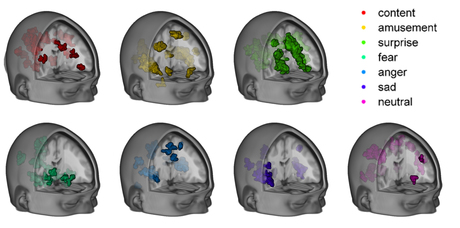Imaging emotions in an idle mind

Duke University researchers have revealed that they can ‘see’ emotional states in the human brain using magnetic resonance imaging — even when their subjects are just letting their minds wander. Their study, published in the journal PLOS Biology, has confirmed that brain patterns associated with distinct emotional experiences also emerge in people who are at rest, with no external stimuli.
“It’s getting to be a bit like mind-reading,” said study leader Professor Kevin LeBar. “Earlier studies have shown that functional MRI can identify whether a person is thinking about a face or a house. Our study is the first to show that specific emotions like fear and anger can be decoded from these scans as well.”
The research team had previously identified seven different patterns of brain activity reflecting contentment, amusement, surprise, fear, anger, sadness and neutrality. In their new study, they scanned 21 university students who were not offered stimuli but were instead encouraged to let their minds wander. Every 30 seconds, the participants responded to a questionnaire about their current emotional state.
Data for the whole brain was collected every 2 seconds and each of these individual scans was compared to the seven patterns. The team examined the scanner data for the 10 seconds previous to each self-report of mood and found that the algorithm accurately predicted the moods the subjects self-reported. In addition, there was a significant signal of anxiety at the beginning of each subject’s data as they enter the confined, noisy MRI for the first time.
“That’s what you’d expect to see for most people when they first enter the machine,” said Professor LeBar.
In a second group of 499 subjects, the researchers had them rest in the scanner for nearly nine minutes, then asked them how depressed and anxious they felt after the scanning session. “We found that the cumulative presence of our ‘sad’ emotion map, summed over time, predicted their depression scores, and the cumulative presence of our ‘fear’ emotion map predicted their anxiety scores,” Professor LeBar said.
This larger group was also tested for personality measures of depression, anxiety and angry hostility. Again, the maps for depression and anxiety closely mirrored these measures. “We also showed that the cumulative presence of our ‘angry’ emotion map predicted individuals’ angry hostility traits,” Professor LeBar said.
Professor LeBar believes these new maps of emotional states could be useful in studying people who have poor insight into their emotional status (such as those suffering from alexithymia). They might also be used in clinical trials to test the effectiveness of treatments to regulate emotions.
'Phantom chemical' in drinking water finally identified
Researchers have discovered a previously unknown compound in chloraminated drinking water —...
Flinders facility to use the micro realm to understand the past
AusMAP aims to revolutionise the ways scientists address key questions and grand challenges in...
A new, simpler method for detecting PFAS in water
Researchers demonstrated that their small, inexpensive device is feasible for identifying various...




